Where's the HFT information gradient?
This is total conjecture; please correct me in the comments, because I don’t understand finance at all. This is from a physics standpoint.
In markets, money flows against an information gradient. Traders with perfect knowledge of a stock’s value in the future can make trades with no risk, yielding the highest expectation values of returns E[R]. Traders with zero knowledge of the stock’s value have the worst expectation value. If the market is conservative–that is to say, there is no money added or lost inside the market itself; a stock sells for x dollars and is purchased for x dollars in each transaction, the sum of all expectation values over traders
S = Σ0^n E[R(tradern)]
Wedding Invitation
Bob and Sarah are a physicist and chemist, respectively. They should have known better than to send us mad libs for an RSVP card.

Translation: On July 23rd, Bob and Sarah will finally be elements of the set of unordered pairs of people. Kyle is very (the official sequence ID of the “happy numbers”) for them, and wishes them an uncountable infinity of happiness and that they should be an ideal example of the wedding ring together. Therefore, 1 will, with less than 1 percent conformance with the null hypothesis, attend and look forward to seeing the undefined (as bride/groom is indivisible) in their Klein bottle dress/suit.
Physics News
Researchers at KERN (the Kyle Eats Ridiculously Nook) have announced reactions of unprecedented energy. The upcoming paper is expected to place new upper bounds on the maximum mass of the T-Burgeron. Results from the TASTEBUD array and Digestive Calorimeter are said to be “off the charts.”
Quantum foam researchers are eagerly awaiting the results of the supersymmetric supersalad (S4) experiment, which is the first to explore symmetry breaking between feta cheese and fresh c-tomatoes. High activation energies in fork-lettuce interactions have long limited the experimental accessibility of the salad model, but new models of bound arugula-cucumber pairs suggest a “delicious island of stability” may lurk at larger plate sizes.
Superstring theorists continue to argue that all vegetables are fundamentally stringlike, but thus far only beans have been proven to meet the topological constraints.
Unlimited Wireless Data?
We’ve been talking at the office about wireless devices receiving video. I’ve been wondering: will cell phone data services keep getting faster? Or is 4G actually running up against the physical limits of the spectrum?
As it turns out, the Shannon entropy limit for these kinds of channels is roughly 6 bits/second per Hz. 4g radios are approaching 5 bps/Hz. Technologically, at least, we’re almost out of room. We can push about 50Mbps over a 4g link, given the allotted frequency space for wireless data. The only real improvement we can make is to repartition the spectrum.
Beer Question #1
One of my professors, Arjendu Pattanayak, used to defer hairy questions in class with “That’s a beer question—meaning, buy me a beer at the pub, and we’ll talk about it.”
In that spirit, I will buy anyone who can explain this as many beers as it takes:
In general relativity, spacetime curvature is proportional to the stress-energy tensor T. T’s components are basically four-momentum density and flux, which are characterized as “momentum” and “energy”. Photons count. So do other particles with with four-momentum. Does anything else contribute? Electrostatics? The vector potential? The strong nuclear force? What is it that makes something contribute to T?
Physics Fail: Conservapedia Edition
I’ve seen a lot of misunderstood physics out there, but watching Andy Schafly try to insist general relativity is wrong and useless has got to take the cake. Kate Sorenson tries patiently to correct the GR article’s mistakes, but is eventually banned for her troubles. Andy finishes with this amazing quote:
One way to evaluate religions, or quasi-religions, is to look at the fruit it bears. What has it helped achieved? In the case of relativity, it has produced nothing. Nil. Zippo. After nearly 100 years and a ton of money. If you find the math in relativity fun, great, but relativity is not going to help anyone. It never has. Pick up a Bible in between some equations.–Andy Schlafly 18:31, 15 November 2009 (EST)
Comps Grade, New Book
Two things of note this week: I received distinction on my Comps, and submitted the first draft of Character in the Dark, my new book, to Blurb. If the copy I get back looks good, I’ll put it up for sale.
I originally intended to work with Engage Print like I did for Sampling Error, but I’m running into logistical constraints. First, it’s not really practical for me to bind more than 6 copies by hand, and I’d like to make the book available to a wider audience. Second, Engage’s Indigo printer can only run up to 12x18", which is slightly too small to really give the images good space on the page.
Hence, I’m sacrificing the pleasure of hand-making the book, and having good control over color/paper, for the convenience of Blurb’s automated print-on-demand system. I’m guessing price will be somewhere around $60; details when I finish the final version.
Comps Done
My comps is done.
I just finished writing version three—the final release, as it were—of my senior thesis, or “comps”, for Carleton. It’s an introduction to the Casimir effect, integrating aspects of quantum electrodynamics, thermodynamics and statistical mechanics, numerical modeling, material science, history of science, and a sampling of experimental literature. There is no original research here (save correcting a typo in the parallel-plates derivation which I suspect everybody knew about). It’s just an exercise in figuring things out, and explaining them to others.
I wrote the paper from books, papers, and discussions with my advisors and peers over the last six months. Last term, I also delivered a 70 minute general-audiences talk, which went pretty well. Since then I’ve been integrating feedback from faculty and peer advisors over two rounds of review. Since the beginning their feeling has been positive, but I have finally (I hope) addressed all remaining concerns with the paper. This version may be tagged “stable”.
Comps Talk
Well, I gave my comps talk (senior thesis) on the Casimir effect last week. It went surprisingly well, though it took much longer to prepare a 70 minute lecture than I expected. There are few graphics on the web which really explain the effect in a sensible way, so I had to draw most of them myself. The audience even seemed to follow quite a bit of it—impressive for starting from ground zero and moving rapidly to quantum cavity electrodynamics.
When I went in to meet with my faculty advisor the next day, I was surprised to learn that the reason he had not kept any of our meetings, or indeed showed much interest in discussing my comps at all, was because he had somehow not realized that he even was my advisor! Apparently, when I finished the talk and he saw his name on the final slide, he was very startled and realized his mistake. I am somewhat disappointed by this, but on the other hand, it was nice to get away without significant critique.
All in all, he said it was a very nice talk, so I’m happy with it–even though I did place a-dagger instead of a on my vacuum cleaner. :) There are still two drafts remaining, but somehow this feels like the finishing point of comps.
Zeta Function Regularization
In a discussion tangent to our research, Arik just managed to explain the mechanics of Zeta-function regularization in the Casimir effect in a (mathematically) action-packed half hour. This conversation cleared up two days of confused scribbling–because now I accept that infinity is, in fact, equal to -1/3.
I’m dreaming math again. I had the weirdest semi-conscious dreams about water slides and renormalization theory. When my first draft goes in, I am going to enjoy taking the weekend off. Two weeks left!
Fall 2008
Term’s almost over; one final left. Research reached a nice finishing point this week; I finished the comparative Lyapunov analysis and prepared the graphs for submission. Noise really kills the linearity we’re looking for, but it does suggest an experimentalist will see some unexpected things, which is what the original paper tried to show with power spectra–and moreover, the figures are in the right ballpark for More on that when we draft a response to PRL.
Tested for 2nd kyu this week. It was tough–especially remembering the right vs. left distinctions for techniques that sound very similar in Japanese! Mechanically things felt pretty solid, though, which was nice. I was even able to clear 3 feet on jumping-over-partner, which was a great feeling. Plus, the front strike continuation is just plain awesome.
Other than that, planning a second book, which will explore the various off-limits parts of Carleton, getting ready for Comps, and starting the post-graduation job search. Now, back to that last paper!
The Surface of Graphite
For the last lab of the term, we learned how to use the scanning tunneling electron microscope, or STM.
<img src=“/data/posts/93/graphite.png” style=“width: 100%”, alt=“Graphite STM image” />
This is an image of the surface of a flake of graphite–the same stuff pencil lead is made out of. We take a small block of graphite and peel off layers using Scotch tape, then mount them on the bed of the STM. An extraordinarily sharp needle, with a tip only a few atoms thick, is given a small electric charge, and positioned a few angstroms above the sample. Electrons then tunnel across the gap between the needle and the surface at a small rate, yielding a current. We sweep the needle across the surface using piezo crystals, and measure the height/current data at each point. That data yields an image, which we’ve filtered with an FFT to show the structure more clearly.
Transverse Laser Modes
These are pictures of various transverse electromagnetic modes for the laser we’re working with.
Laser beams aren’t constrained to being nice little smooth dots, though that’s one of the possible modes (TEM00). Since TEM00 has the most tightly focused beam, and the fewest irregularities, it’s the one many laser manufacturers force their device to operate at. There are other possible solutions, with varying patterns. The subscripts here indicate the number of divisions in the beam—I’m guessing on some of the higher ones. There’s also a strange pattern which looks like it has radial, not rectilinear, divisions; I’m not sure what that is, exactly.
 TEM00
TEM00
|
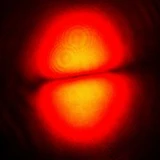 TEM01
TEM01
|
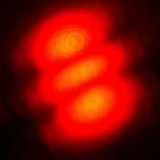 TEM02
TEM02
|
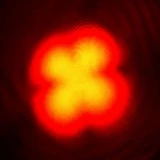 TEM11
TEM11
|
 TEM22
TEM22
|
 TEM23
TEM23
|
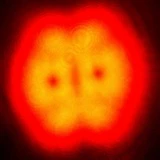 TEM33?
TEM33?
|
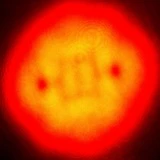 TEM35?
TEM35?
|
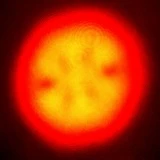 Radial mode?
Radial mode?
|
Fall Term
After six months, I’ve finally tested for pre-third kyu. Sophie was amazing, practicing techniques endlessly, putting up with hundreds of bad throws, and smiling through it all. Thanks to good teachers and hard work, the test went beautifully. I’m really happy about the whole thing: techniques feel more natural, timing comes easier, and now that it’s over, I can take more time to work with beginners! There are a couple of new students who are putting in a lot of hard work, and I’m really excited about how fast they’re learning. I hope some stay!
Being treasurer has been an adventure this term. I finally got the budget figured out… kind of… and then the test came! Proofreading all the paperwork then accounting for various fees and forms took several hours last night, but I think it’s finally in order. Now that I’ve fumbled my way through this test, I think the next ones are going to go a lot better.
The physics ultimate team, Physbee, is still undefeated! The last few games have been spectacular: playing an hour before dusk, the light rolls over the clouds and sweeps over the whole campus. I wish I had real shoes, though: much as I love my hiking boots, they are not the best for sprinting. ;-) Maybe I’ll try and get some this weekend.
In Which Math and Physics Continue to Freak Me Out
So last night, Nik, Max, and I were studying for the philosophy midterm, and we got to talking about the Monty Hall problem. It goes like this: you've got three doors, behind one of which is a fun prize, and behind the other two are nothing. You guess one of the doors, in an attempt to obtain the awesome reward, but before you get to see if you were right or not, some punk named Monty opens a different door, and shows you that there is nothing behind it. You then have the opportunity to change your selection. What do you pick?
Well, we figured, being shown that another door has nothing behind it doesn't change what your original choice was, so it doesn't make a difference as to which door you pick now. Either of the remaining two doors will be equally likely to have the prize behind it, right?
Nope, I was wrong.
Electrostatics, and Then I Found Five Dollars
A couple of funny things happened to me today. Over break I got a series of e-mails with tips for taking the Collegiate Learning Assessment, a scenario-based assessment of critical thinking skills. The names for each tip started with the letters B and S: "Be Specific", "Be Skeptical", etc.* However, the e-mail for tip number four was:
TIP #4: READ DIRECTIONS ($5.00 extra to anyone who can come up with a version of this tip's name that starts with an “S”) Check that you’ve done what you’ve been asked to do. If you’re being asked to play a role, think about who you are suppose to be writing for. Don’t assume that your audience knows what you’re writing about.
I fired back a tongue-in-cheek response, suggesting a bunch of S-phrases like "Satiate Curiosity", "Suppose Nothing", "Study Directions", and so forth. I didn't realize they were serious about the money, but a week later I got a response: they wanted me to stop by the Dean's office and pick up the five dollars. That was... rather unexpected. :-)
Winter Term 2007
To sum up the last term:
I took three classes: Ordinary Differential Equations, Japanese 205, and Classical/Computational Mechanics, affectionately (though with a thin edge of nervousness) referred to by many physics majors as "Classy" and "Compy". These last two ate me alive: the average weekly problem set was 18 hours in length, although one went up to 25 hours. I spent a lot of mornings (9:00 P.M. -- 3:00 A.M.) in Olin, the physics building, staring at Mathematica and struggling through Lagrangians. "You know, the windmill is really pretty at sunrise," my friend Max told me. "You can see it through the windows of the Olin hallway."
The last two weeks of the term were consumed by a massive final project: building and modeling a tinkertoy siege engine with the use of Lagrangian and Hamiltonian mechanics. My partner and I wrote hundreds of lines of code, and dozens of pages of equations, trying to model the energy transfer between the pendulum falling and the motion of the wheeled base. The problem consumed my life; walking to dinner, waiting in line, even in other classes, I'd think about drag models, wheel inertia, and projectile efficiency. We worked somewhere around 60 hours per person over two weeks.
